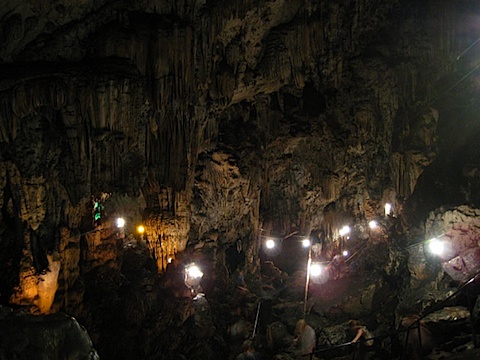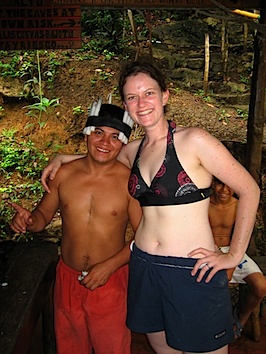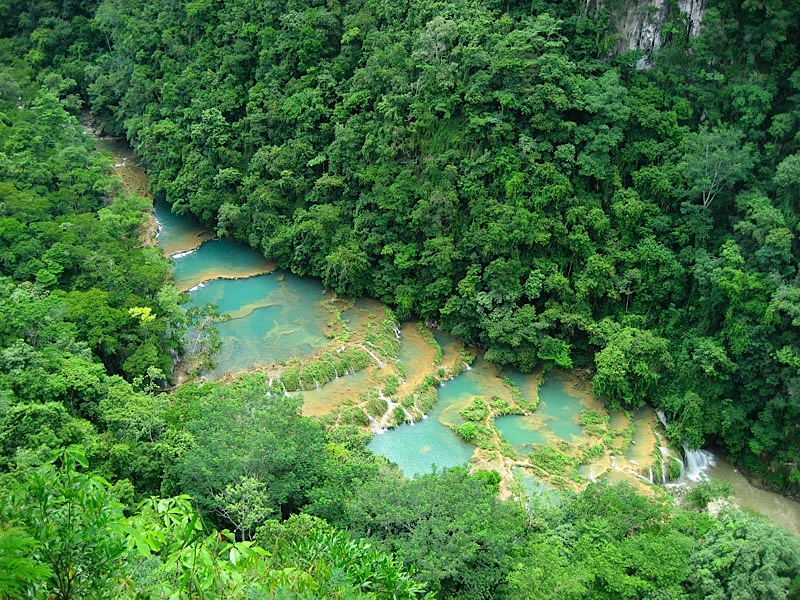Emily made me promise that before we left Guatemala, we’d see Semuc Champey, the only major attraction we didn’t get to in our two years of service. It’s been a while since we’ve “traveled” in the fun sense of the word, so these few extra days between our Close of Service and return to the US seemed like a good chance to tie up this loose end.
In Lanquin, the closest town to Semuc Champey, there aren’t a lot of lodging options. Two backpacker hostels cater to tourists like ourselves: El Retiro, which has a reputation for being a pretty extreme party at all hours of the day, and The Zephyr. It has really good reviews, despite being only 8 months old (El Retiro is about 15 years old), as well as hot showers, a few private rooms, and a lot of nature close by.
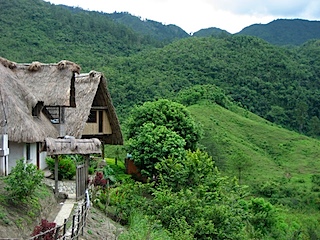 “I dunno,” Anne said as we talked to her last week about our plan. “I stayed at the Zephyr when I went to Semuc Champey in November, and they lost my reservation. I had to sleep in the attic with the cockroaches! They’re a bunch of disorganized hippies.” She wrinkled her nose.
“I dunno,” Anne said as we talked to her last week about our plan. “I stayed at the Zephyr when I went to Semuc Champey in November, and they lost my reservation. I had to sleep in the attic with the cockroaches! They’re a bunch of disorganized hippies.” She wrinkled her nose.
Not to be put off by hippies, we turned up yesterday at The Zephyr after a loooooong 9-hour ride in a microbus. “Sorry, but we seem to have lost your reservation,” the friendly guy at the desk said in a moderate British accent.
“You’d better look again,” Emily said, putting on the Battle Hat despite her fatigue, and wondering why we didn’t listen to Anne.
He did so, only to find that they DID have our reservation, but it was written on a different paper that no one ever looks at, and all the rooms were already given away. “If you want, you can have the bed in the attic,” he offered apologetically, “and we’ll knock a little off the price.”
After verifying there would be a proper room the following days, Emily sighed at the irony of the situation and accepted the attic bed. We were so beat from the last two weeks of goodbyes, running around, and paperwork, that we were too tired to look elsewhere. I hauled our stuff up the ladder into the attic as Emily went to check out the showers.
I set my pack down at the bedside, listening to the music blaring from the bar downstairs. A quick look at the structure revealed that the speaker for the sound system below us is about three feet from our bed, on the other side of a bamboo wall. A bamboo wall with poor acoustic qualities, as you might imagine. What I didn’t imagine was that that speaker would be blasting music until 5am the next morning, which it did with gusto.
“Showers are cold,” Emily said, frowning, as she poked her head up through the hatch in the floor. She climbed up in to the attic to join me, then stared over my shoulder at the bed. “What’s THAT?”
I turned around. “Oh, it’s a two-inch long cockroach crawling across the bedsheet. Wonderful.”
At that point, we gave up and settled in for a fitful night of screaming guitar riffs, beer-and-cigarette smells, and sex noises from the dorm bunks next door.
Luckily, the next day our room became available (complete with hot shower) and after a long nap to make up for lost sleep, we got back onto the right foot. That evening, a local Q’eqchi guide was offering tours of the caves in Lanquin. The departure time? 5pm, so you could hang out and see the bats leave for their night’s business.
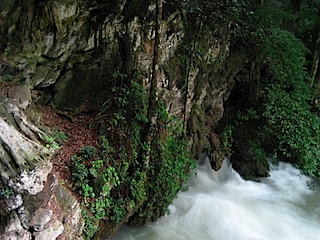 We took a tuk-tuk to the cave a few kilometers away, paid our fee to the man in the little shack at the trailhead, and hiked a few hundred meters in. The cave entrance itself was a crack above a stream that gushed forth from the mountainside, sortof like Faramir’s hideout in The Lord of the Rings. This analogy turned out to be slightly off, though, once we were inside and realized we were actually in Moria. Perhaps I am too obsessed with Tolkein’s masterwork, but there are a lot of cool Tolkein-esque natural wonders in Guatemala that would make it a good runner-up for filming the trilogy…if only they had the technology and social infrastructure to match New Zealand.
We took a tuk-tuk to the cave a few kilometers away, paid our fee to the man in the little shack at the trailhead, and hiked a few hundred meters in. The cave entrance itself was a crack above a stream that gushed forth from the mountainside, sortof like Faramir’s hideout in The Lord of the Rings. This analogy turned out to be slightly off, though, once we were inside and realized we were actually in Moria. Perhaps I am too obsessed with Tolkein’s masterwork, but there are a lot of cool Tolkein-esque natural wonders in Guatemala that would make it a good runner-up for filming the trilogy…if only they had the technology and social infrastructure to match New Zealand.
As we hiked into the caves, it soon became apparent that the cavern complex was elaborate: a half-dozen main chambers, some of which were fifty or sixty feet high. “This is a lot like the caverns at Cave Junction in Oregon, or Luray Caverns in Virginia,” I said to myself as we explored. This is when I found out that Emily had never been in a cave before. What? How can that be possible? Caves are incredibly cool. But I guess there aren’t many in northern Indiana.
We passed stalactites, stalagmites, curtains, pools, and all sorts of cool geologic wonders. The caves were remarkably free of graffiti and abuse, a rarity in the third world. We saw a name and “1966” painted high up on one wall, apparently left by one of the first professional explorers, and then came to a flat area atop a high shelf. The entire area was black with soot. “This is where the Mayan priests come to burn offerings of incense and copál,” our guide explained. “For hundreds of years, up until a few years ago, they were the only ones that ever came into the cave.” A few years back, the locals realized the tourism potential for the cave, strung up some electrical lights, built a little guard shack, and are doing a respectable job at keeping it vandalism free. Most of the tour companies around here are owned and operated by Guatemalan Mayans, something they’re proud of and working to continue, fighting off foreign megabusinesses that threaten to commercialize the industry and monopolize the market.
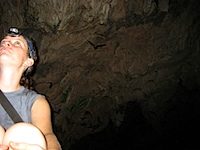 When our tour ended, we returned to the entrance of the cave. “It’s almost dark, the bats should be starting soon,” he said as he looked at his watch. “Turn out your lights, and we will wait.”
When our tour ended, we returned to the entrance of the cave. “It’s almost dark, the bats should be starting soon,” he said as he looked at his watch. “Turn out your lights, and we will wait.”
A dozen or so of us waited, lights out, as the last rays of the evening sun casting a dim light into the first chamber. I was pondering how bats could know it’s time to do their thing, since it’s eternally night in the caves, when I noticed that the roof was swimming. OK, not really “swimming”, but it looked like a river was running along the ceiling in all the nooks and crannies, like gravity was reversed.
“Ok, turn on the flash of your cameras, and shoot at the roof,” the guide advised us. Poof! Flashes went off, and we realized there were THOUSANDS of bats zoming everywhere. Within minutes, they were zipping around us, streaming out the entryway. It was like the Dan Ryan Expressway at 5:30 pm on a Friday night. Bats everywhere! But unlike on Scooby Doo, the swarm of bats howling out the cave entryway did it in total silence. “They are just getting started,” the guide advised us. “There are millions in here.”

The next day, we made it to Semuc Champey proper. The entire region is filled with limestone, moving water, caverns, and karsts. The morning’s event? Checking out another cave. This one, however, was filled with water.
About a decade ago, I visited New Zealand for a few months, and tried Blackwarer Rafting while I was there. The Kiwis have tourism down to a science, and really make use of their cool natural wonders: in “blackwater rafting”, the idea is that you float the rapids in a water-filled cave complex. Sounds ridiculous, but it’s pretty cool. To prepare, the guides equip you with a wetsuit, water shoes, life preserver, helmet, headlamp, rock climbing harness, and (of course) an inner tube. Hey, I said they made it a science, right?
In Guatemala, for the exact same trip, you get: a candle.
Yep. We all stripped off our clothes down to a bathing suit, were each given a candle, and plunged into the mysterious world of undeground waterways. The guide was a little better equipped: he had a headband made from a strip of old innertube, into which he stuck a half dozen extra candles.
It was truly amazing seeing the mysteries of the deep by candle light, and it made me feel even more like Gimli, Gloin’s son as I held up my lone flickering flame to check out deep crevasses, towering spires, and dripping stalactites. As we dogpaddled our way along, gripping candles between our teeth, I though about what it means to “adventure” in the third world. Most of humanity doesn’t know about liability insurance, tort law, and negligence lawsuits. People are expected to act reasonably to safeguard their own wellbeing. In the US, coffee cups say “Caution: Hot Coffee” so McDonalds doesn’t get sued again when some moron burns themselves on the hot beverage they specifically ordered that way. Geysers have guardrails. Scenic overlooks have fences. I’m not saying that leaving the handrail off of a stairway with a 100-foot dropoff is a good idea (seen it), but sometimes the lack of over-protectiveness here is charming in a way, and shows us things that would never be possible back home. It’s life in the raw, it’s being responsible for yourself… it’s seeing millenium-old natural wonders by candlelight, and it can be beautiful.
The final part of the tour was the star of the show: the pools of Semuc Champey. This photo is the one I think of as “the money shot,” one of the most famous in all of Guatemala. Semuc Champey translates into “where the water goes underground” in the local Mayan dialect, and that is exactly what you’re seeing here. A giant raging river drops through an enormous hole in the ground at the top left of the photo, due to a strange geologic condition, and flows under massive plates of limestone. The plates, in turn, are covered with a small percentage of water that doesn’t fit thorugh the hole, forming beautiful green pools of slow-moving water that are arranged like giant stairs down the hillside. At the bottom, the river comes raging back out of the exit hole, about 50 feet wide and a reported 25 feet deep. THAT is a lot of water.
We hiked all over the site in the steamy jungle heat, climbing the limestone cliffs to get the money shot, then back down to swim and wade in the scenic pools. The cool water of the caves and then the pools, alternated with the oppressive humidity of the jungle, made for a really enjoyable day.
Back at the hostel, we had a beer to celebrate a good day. I’m not much of a beer person, but we’ve discovered something new in Guatemala: Russian beer. It’s all the rage in the more touristy areas, and feels strangely at home in this weird country of Korean-made cars, Chinese-made electronics, Indonesia-made condoms, and yarn from the Ivory Coast. This particular company, Baltika, has four different beers that are regularly available here: 5, 6, 7, and 9. Hah, yeah, the different varieties just have a number, not frivolous names like “Special Draft Amberbock.” Russians are very cool that way, all business, just like their airplanes. Here’s our take on the beers:
5: A lighter beer, tastes like a heffeweisen. Probably our second favorite, and it’s really good with a lime in it.
6: Stout, like Bass or Guinness if it didn’t have the burnt taste. Strong molasses flavor makes it not so good with food. But if you’re hungry? Yumm, like the monks of old who drank doppelbock to sustain themselves whilst fasting.
7: We like this one the best. It’s a medium lager, sortof like Heineken, and comes in a green glass bottle. It’s the only one with a pull tab to open it. What?
9: DANGER. RED ALERT. This one tasts like beer, but is actually a mechanism to cause inebriation in the incautious. It’s a crazy 8% alcohol, very high for a beer and challenging some wines. We first tried it at the tasty falafel place in Antigua after a full day’s camioneta ride. We were starving and the restaurant owner (who is a friend of ours) recommended it, so we tried it. Unfortunately, we’d not eaten all day and the food was slow in coming, allowing us to finish the entire beer before the food arrived. Despite the fact that we’d SPLIT the bottle between the two of us, we had trouble finding our hotel room that evening.
